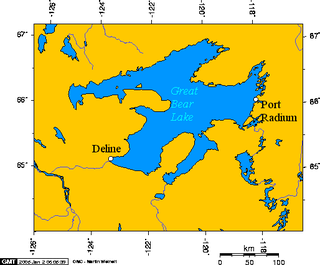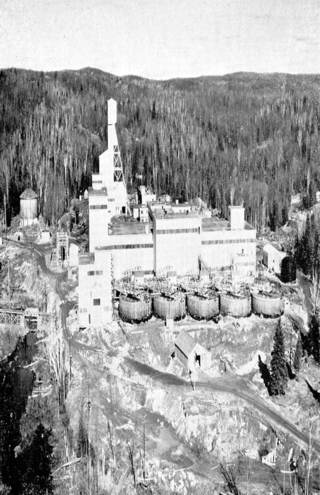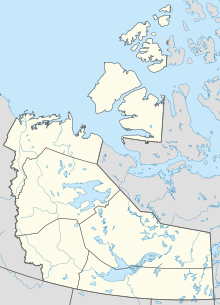
Uraninite, also known as pitchblende, is a radioactive, uranium-rich mineral and ore with a chemical composition that is largely UO2 but because of oxidation typically contains variable proportions of U3O8. Radioactive decay of the uranium causes the mineral to contain oxides of lead and trace amounts of helium. It may also contain thorium and rare-earth elements.

Port Radium is a mining area on the eastern shore of Great Bear Lake, Northwest Territories, Canada. It included the settlement of Cameron Bay as well as the Eldorado and Echo Bay mines. The name Port Radium did not come into use until 1936 and at the time it was in reference to the region as a whole. The Eldorado mine site at LaBine Point adopted the name for its settlement in the 1940s and it has generally stuck.
Gilbert A. LaBine, was a Canadian prospector who, in 1930, discovered radium and uranium deposits at Port Radium, Northwest Territories. LaBine was president of Eldorado Gold Mines from its start in the late 1920s to 1947. He left the company, which had become a Crown corporation in 1944, to prospect for uranium minerals as an independent mine developer. In the 1950s he brought the Gunnar Mine to production at Uranium City, Saskatchewan.
Eldorado Resources was a Canadian mining company active between 1926 and 1988. The company was originally established by brothers Charles and Gilbert LaBine as a gold mining enterprise in 1926, but transitioned to focus on radium in the 1930s and uranium beginning in the 1940s. The company was nationalized into a Crown corporation in 1943 when the Canadian federal government purchased share control. Eldorado Resources was merged with the Saskatchewan Mining Development Corporation in 1988 and the resulting entity was privatized as Cameco Corporation. The remediation of some mining sites and low-level nuclear waste continue to be overseen by the Government of Canada through Canada Eldor Inc., a subsidiary of the Canada Development Investment Corporation.
Echo Bay Mines Limited was a Canadian company which was organized in 1964 by Northwest Explorers Limited to develop a silver deposit at Great Bear Lake, Northwest Territories, Canada, which had been staked in 1930 by The Consolidated Mining and Smelting Company. The company leased the old Port Radium settlement from Eldorado Mining and Refining Limited and used the old camp and mill to recover silver and copper values from what became known as the Echo Bay Mine. Production in the Echo Bay workings ceased in 1975. The company then reopened the old Eldorado Mine workings and produced more silver and copper until 1981, when low silver prices caused the mine to close permanently.

Uranium mining in Colorado, United States, goes back to 1872, when pitchblende ore was taken from gold mines near Central City, Colorado. The Colorado uranium industry has seen booms and busts, but continues to this day. Not counting byproduct uranium from phosphate, Colorado is considered to have the third largest uranium reserves of any US state, behind Wyoming and New Mexico.

Madawaska Mine (previously known as Faraday Mine) is a decommissioned underground uranium mine in Faraday, near the town of Bancroft, Ontario, which produced 9 million pounds (4,082 tonnes) of U3O8 concentrate, at an average ore grade of 0.1074%, during its two periods of production.

Marine Transportation Services (MTS) formerly Northern Transportation Company Limited (NTCL) is a marine transportation company operating primarily in the Mackenzie River watershed of the Northwest Territories and northern Alberta, and the Arctic Ocean using a fleet of diesel tug boats and shallow-draft barges. NTCL filed for bankruptcy in 2016 and its assets were acquired by the Government of the Northwest Territories later that year.

The Buckles Mine is an historical uranium mine located approximately 4.5 km southeast of Elliot Lake, Ontario, owned and operated by Rio Algom Ltd. The site has been rehabilitated. Environmental monitoring is ongoing as part of the monitoring for the nearby Nordic Mine.
Consolidated Denison Mine, or the Denison Mine is an abandoned uranium mine located approximately 12.5 km north of Elliot Lake, Ontario. The site is bordered north by Quirke Mine and New Quirke Mine; on the east by Panel Mine and Can-Met Mine; and south by Spanish American Mine and Stanrock Mine.

Canada is the world's second-largest producer of uranium, behind Kazakhstan. In 2009, 20% of the world's primary uranium production came from mines in Canada. 14.5% of the world production came from one mine, McArthur River. Currently, the only producing area in Canada is northern Saskatchewan, although other areas have had active mines in the past.
The Beaverlodge Mine sometimes referred to as the Eldorado Mine or the Beaverlodge Operation was a uranium mine in the community of Eldorado, northern Saskatchewan, Canada. Eldorado was a small community 7 kilometres (4.3 mi) east of the community of Uranium City, Saskatchewan in the Beaverlodge Uranium District built by Eldorado Mining and Refining Limited to house the workforce and families of the mine.
The world's largest producer of uranium is Kazakhstan, which in 2019 produced 43% of the world's mining output. Canada was the next largest producer with a 13% share, followed by Australia with 12%. Uranium has been mined in every continent except Antarctica.

Bicroft Mine is a decommissioned underground uranium mine, located in Cardiff, near Bancroft, Ontario, Canada.

Dyno Mine is a decommissioned underground uranium mine located at Cardiff, near Farrel Lake, approximately 30km southwest of Bancroft, Ontario. It operated from 1958 to 1960.

Greyhawk Mine is a decommissioned underground uranium mine located in Faraday Township near Bancroft, Ontario. It operated from 1954 to 1959 and from 1976 to 1982. The mine produced 80,247 tons of uranium ore, of which 0.069% was U3O8 worth $834,899.

Uranium mining around Bancroft, Ontario, was conducted at four sites, beginning in the early 1950s and concluding by 1982. Bancroft was one of two major uranium-producing areas in Ontario, and one of seven in Canada, all located along the edge of the Canadian Shield. In the context of mining, the "Bancroft area" includes Haliburton, Hastings, and Renfrew counties, and all areas between Minden and Lake Clear. Activity in the mid-1950s was described by engineer A. S. Bayne in a 1977 report as the "greatest uranium prospecting rush in the world".

Uranium mining in the Elliot Lake area represents one of two major uranium-producing areas in Ontario, and one of seven in Canada.

The Gunnar Mine was an active uranium mine in northern Saskatchewan, Canada, located approximately 25 kilometres (16 mi) southwest of the community of Uranium City and approximately 600 km (370 mi) north of Saskatoon. This mine is situated on the Crackingstone Peninsula on the north shore of Lake Athabasca in the Beaverlodge Uranium District.

South Terras Mine is a disused uranium and radium mine near Grampound Road and St Stephen-in-Brannel, Cornwall. Prior to producing primarily radioactive ores, it also produced tin, iron, and ochre. In 1996, it was designated a site of special scientific interest for the variety of unusual and rare minerals.

















